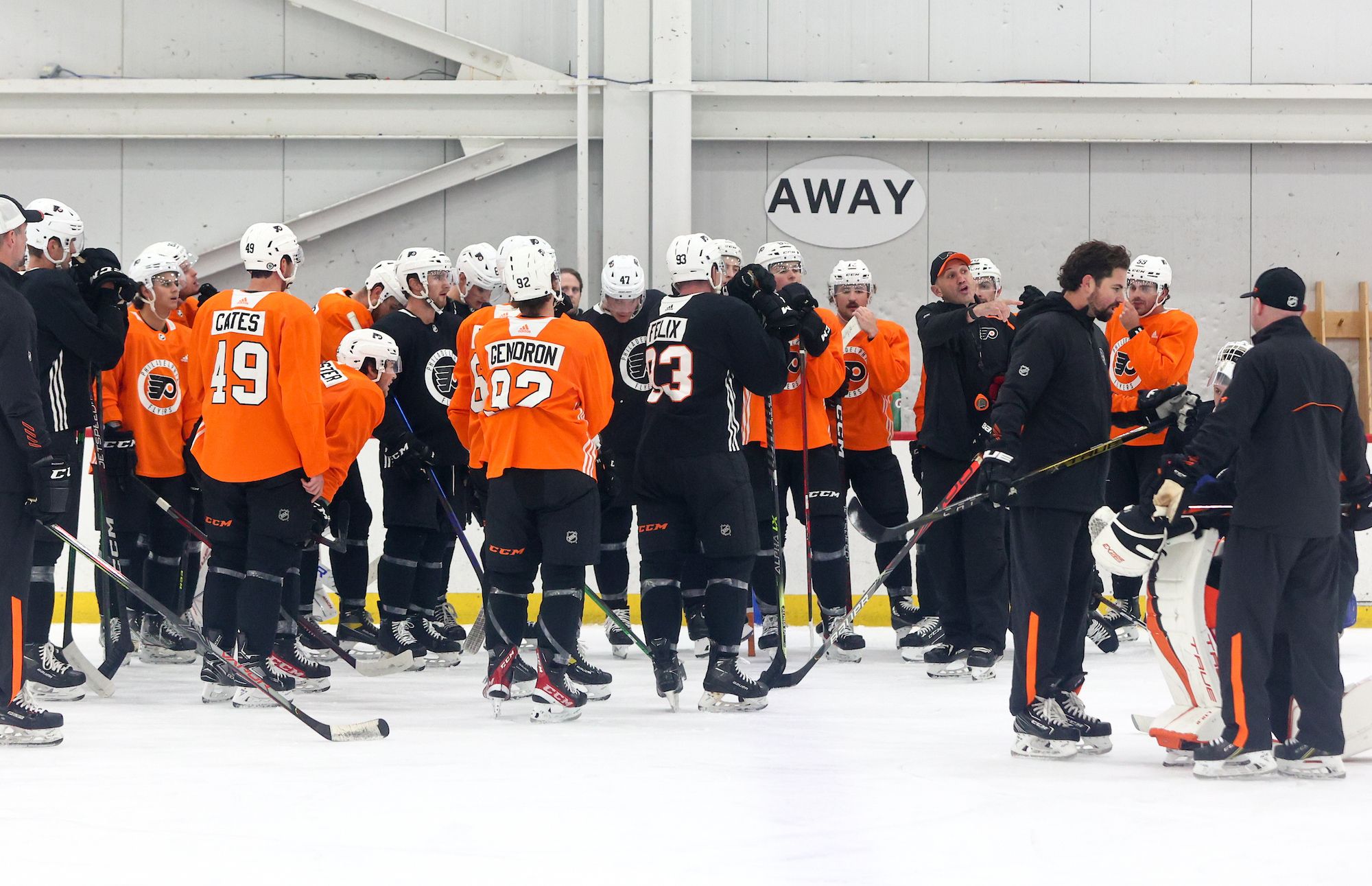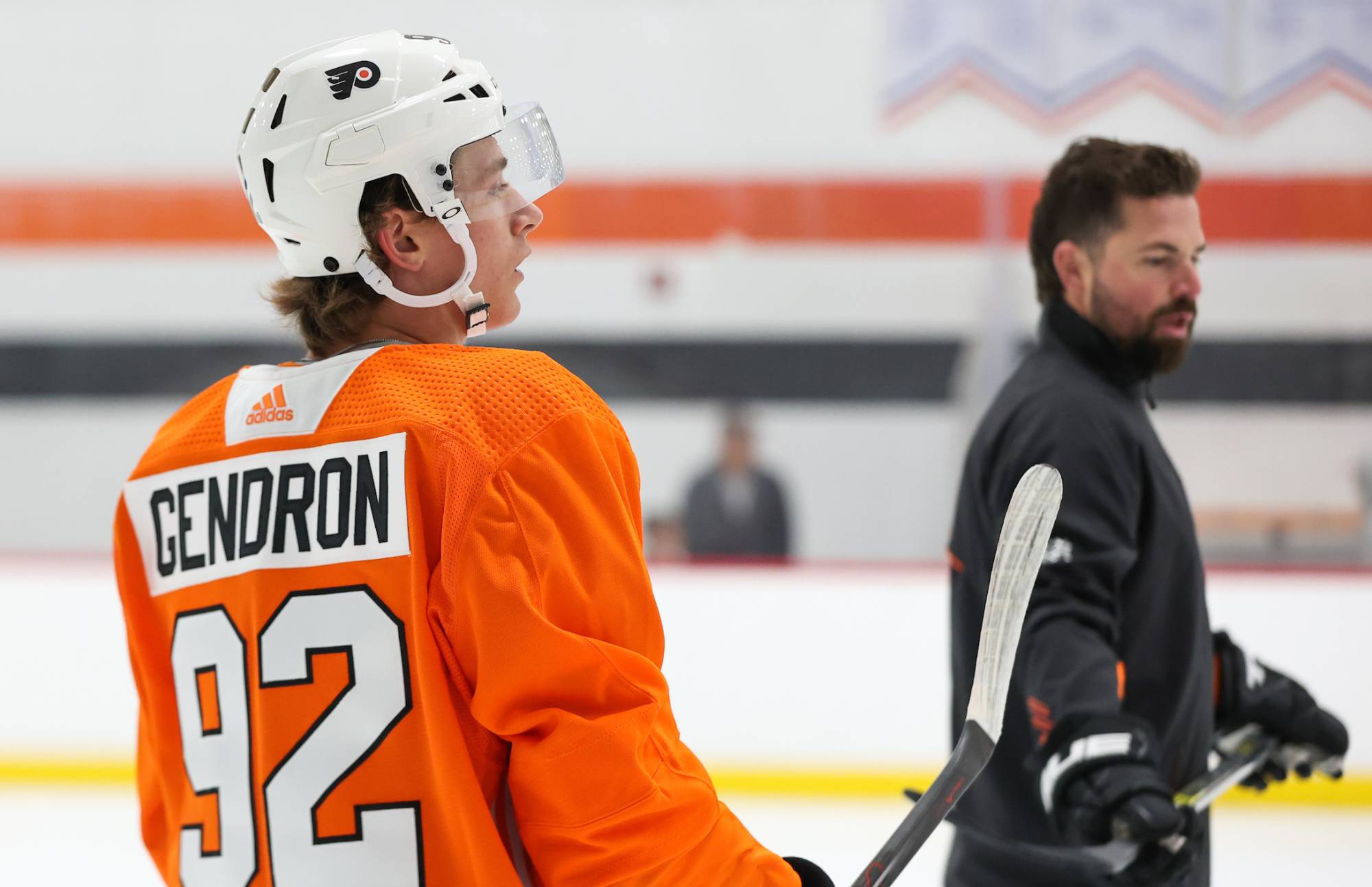On Monday, we did a re-introduction to the concept of zone entries, and laid out the type of information we’re learning about the 2013-14 Flyers from this data on zone entries.
Today, we’ll start breaking into that information by looking at some of the base-level numbers, with two goals in mind: figuring out which players are entering the offensive zone most frequently, and figuring out which players are doing so with control of the puck most often (which, as you may recall, is the goal).
So let’s just get right to the data. When Eric really dug into this stuff for the first time two years ago, he found three skills in individual puck-handling that could reasonably have been deemed repeatable on a single-season basis:
- Entries per 60 — how often did that player send the puck into the offensive zone?
- Individual entry percentage — of the team’s entries with the player on the ice, how often was this player the one sending the puck in?
- Percent of entries with possession — of the times that the player sent the puck in, how often did he retain possession (carry or pass) rather than dumping the puck in? (Remember, entries where the team retains possession generate twice as many shots as dump-ins, so this is a measure of how effective the player’s zone entries were.)
We’ll discuss entry percentage a bit later on in the series. For now, we’ll mainly be focusing on the first and third points on that list, meaning we’ll mostly just be looking at how often players retained possession of the puck at the blue line, as well as how frequently (in total) they were bringing the puck into the offensive zone, adjusted for ice time.
The forwards
We’ll look first at the team’s forwards. Below, you’ll see each of the team’s top 12 forwards on the year. As always, this data is for the 2013-14 regular season only, and only reflects play at 5-on-5.
| Player | 5-on-5 TOI | Control % (Rank) | Fail % | Total entries/60 | Controlled entries/60 | Dump-ins/60 | Failed entries/60 |
| Voracek | 1056.7 | 67.9% (1) | 8.9% | 25.2 | 18.1 | 7.1 | 1.8 |
| Giroux | 1181.6 | 54.9% (2) | 7.4% | 21.3 | 12.7 | 8.6 | 1.0 |
| Lecavalier | 823.8 | 52.5% (3) | 11.8% | 17.5 | 9.8 | 7.7 | 1.3 |
| Raffl | 738.7 | 52.5% (4) | 16.1% | 22.6 | 12.7 | 9.9 | 2.4 |
| B. Schenn | 1047 | 52.1% (5) | 15.0% | 18.2 | 10.0 | 8.1 | 1.8 |
| Read | 992.8 | 52.0% (6) | 6.5% | 23.8 | 13.1 | 10.7 | 0.9 |
| Couturier | 1103.2 | 47.9% (7) | 10.4% | 19.4 | 9.8 | 9.6 | 1.1 |
| Simmonds | 1033.4 | 46.1% (8) | 13.6% | 26.1 | 12.9 | 13.2 | 2.0 |
| Downie | 603.7 | 43.5% (9) | 14.4% | 17.2 | 8.2 | 8.9 | 1.4 |
| Hartnell | 1013.9 | 42.2% (10) | 15.6% | 17.7 | 8.3 | 9.4 | 1.5 |
| Rinaldo | 478.6 | 35.2% (11) | 11.1% | 21.7 | 8.0 | 13.7 | 1.0 |
| Hall | 536.3 | 34.0% (12) | 9.3% | 21.6 | 7.6 | 14.0 | 0.8 |
Let’s also look at these numbers in conjunction with last season’s. We don’t have all of 2013’s info available, but at the very least, thanks to Eric’s work last year, we can compare the carry-in percentages for the eight forwards who got regular minutes on both of those teams. Let’s do so.
| Player | Control %, 2014 (rank) | Control %, 2013 (rank) | Change |
| Voracek | 68% (1) | 59% (2) | 9% |
| Giroux | 55% (2) | 65% (1) | -10% |
| B. Schenn | 52% (5) | 58% (3) | -6% |
| Read | 52% (6) | 47% (7) | 5% |
| Couturier | 48% (7) | 48% (6) | 0% |
| Simmonds | 46% (8) | 40% (9) | 6% |
| Hartnell | 42% (10) | 52% (5) | -10% |
| Rinaldo | 35% (11) | 23% (13) | 12% |
There’s a lot you can take away from the above two tables, so here were a few things that stuck out to me:
- The two names at the top of the first list likely come as no surprise, since Claude Giroux and Jakub Voracek have been the two best Flyers forwards (other than Jaromir Jagr, in his one year here) at maintaining possession through the neutral zone for a while now. With that said, it seems pretty evident that this season, Voracek seemed to take on the role of that top line’s primary puck-carrier. This is maybe not surprising when you consider their styles of play — Voracek’s combination of size, speed, and puck-possession ability makes for a deadly combination in this area — but I’m curious as to how and why that swap became so pronounced this year.
- Vincent Lecavalier slid right into Danny Briere’s vacated spot as “possession-deficient top-9 forward who still does a decent job keeping control of the puck into the offensive zone”.
- Michael Raffl in the fourth spot on the list maybe isn’t too surprising, given how he plays the game — guys with speed and smarts are typically guys who can navigate the neutral zone well, and Raffl’s got plenty of both.
- We’ve talked about Wayne Simmonds‘ tendencies to dump the puck in too often, with him being one of the team’s worst top-9 forwards at keeping possession of the puck through the neutral zone. Simmonds’ standing improved a bit this year, as he pulled his numbers up about six percentage points from 2013 to 2014. Still, Simmonds’ tendencies to dump the puck in are exacerbated by the fact that he just does it so much — more than any other top-9 forward on the team. We’ll look at him a bit more when we get into on-ice findings.
- Scott Hartnell has put together solid possession numbers for a few straight seasons now, and this past one was no exception, but this year he did it in spite of a tremendous drop-off in his own abilities to control the neutral zone. Whether his 10 percent drop-off is a matter of circumstance (playing with linemates who do it more often?), aging, bad luck, or something else is up for debate. But regardless, it’s interesting that Ron Hextall — who’s explicitly mentioned wanting to improve the teams’ entries a couple of times this offseason — shipped out the guy whose entry numbers were less impressive than any other top-9 forward.
- In terms of year-to-year personnel, the Flyers lost their fourth-best player at entering the zone with possession from last year (Danny Briere) and their eighth-best (Simon Gagne). Those players were replaced by their third-best player at entering with possession this year (Lecavalier) and their fourth-best (Raffl), which you could argue works out to a net positive.
The defense
Now we’ll look at the defense. We don’t have last season’s carry-in numbers readily available for defensemen, so we’ll only really be able to look at the numbers for this year.
| Player | 5-on-5 TOI | Control % (Rank) | Fail % | Total entries/60 | Controlled entries/60 | Dump-ins/60 | Failed entries/60 |
| Streit | 1335.7 | 48.9% (1) | 8.2% | 10.0 | 5.0 | 4.9 | 0.4 |
| MacDonald | 341.2 | 40% (2) | 5.9% | 6.7 | 2.8 | 3.9 | 0.2 |
| Gustafsson | 477.9 | 34.9% (3) | 0.0% | 7.5 | 2.8 | 4.8 | 0.0 |
| Meszaros | 555.8 | 33.8% (4) | 15.6% | 8.3 | 2.9 | 5.4 | 0.5 |
| Grossmann | 1231.3 | 22.7% (5) | 9.4% | 6.0 | 1.4 | 4.6 | 0.1 |
| Coburn | 1400.9 | 21.6% (6) | 11.1% | 5.7 | 1.4 | 4.4 | 0.2 |
| L. Schenn | 1107.8 | 21.6% (7) | 15.6% | 6.7 | 1.5 | 5.2 | 0.3 |
| Timonen | 964 | 21.5% (8) | 12.8% | 8.4 | 2.1 | 6.3 | 0.3 |
Some thoughts on the above findings:
- This shouldn’t come as a surprise in the slightest, but you’ll notice that defensemen are much less involved in entries than forwards are. Both in terms of percentage of entries with control and overall entries, on average, the defensemen lag well behind the forwards. Again, this is about what you’d expect.
- When the Flyers brought in Mark Streit, it seemed like an obvious attempt to bring more puck-handling ability to a defense that hadn’t shown much of that in the shortened 2013 season. As much as any other measurable number, this table shows how big an impact Streit had in initiating offense from the blue line. He brought the puck into the offensive zone more than any other defenseman, and was far more capable at entering the zone with control than any of the team’s other defensemen were.
- Frequent readers of BSH will know that we aren’t the biggest fans of Andrew MacDonald’s game, and a lot of that stems from his neutral zone defense (not to mention we’re working with a relatively small sample of minutes for him here). Still, from an offensive-zone side of things, seeing him have the second-highest percentage of controlled entries among the team’s regular defensemen is interesting, and admittedly not what I expected to see. He doesn’t strike you as the most active guy with the puck on his stick, but he is a decent skater and passer, which certainly both help in their own ways.
- None of the other defensemen’s numbers seemed too out of line — for the most part, the puck-moving types (Streit, MacDonald, Gustafsson, Meszaros) topped the defensively-oriented types (Coburn, Grossmann, Schenn). But there’s one exception that really makes me scratch my head: Kimmo Timonen. Almost undoubtedly the team’s best blueliner in 2013-14, Timonen actually had the lowest percentage of carry-ins among all Flyers defensemen, and dumped the puck in more than anyone else by either measure. Maybe this shouldn’t be too surprising — Timonen put up similar individual numbers in 2011-12, too. Still, I’d have expected him to end up ahead of the likes of Grossmann and Schenn.
Next up in this series…
So now we’ve got the basic knowledge of who’s getting the puck into the offensive zone, and how exactly they’re doing it. Next time around, we’ll talk about the on-ice numbers that sort of stem from this, including:
- Who’s carrying the neutral zone burden (i.e. who has the highest individual entry percentages, as described at the top of the post)?
- Does anyone seem to be better than others at generating shots off of their entries?
- Is anyone seeing their dump-ins retrieved more than other players? Is anyone better at retrieving dump-ins than other players? Is that talent something that appears to be repeatable?/
***
Ed. Note: If there are any terms or concepts here where the definition or implication isn’t made clear, please don’t hesitate to ask for clarification in the comments here or on Twitter.









